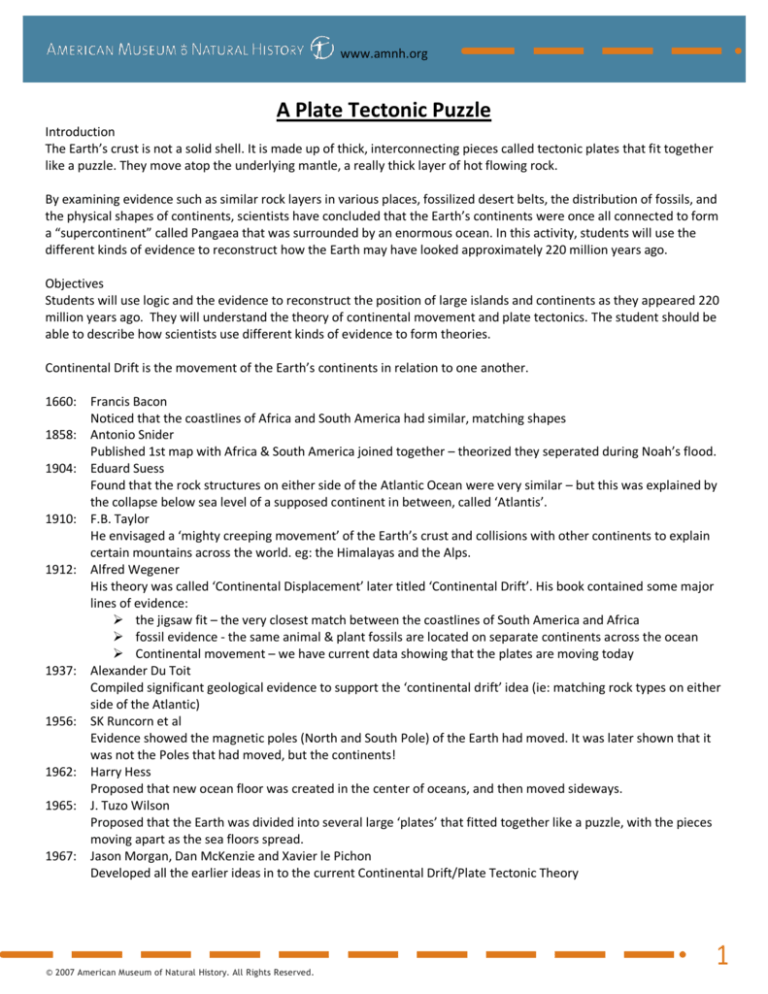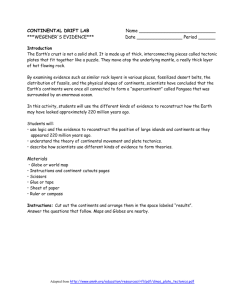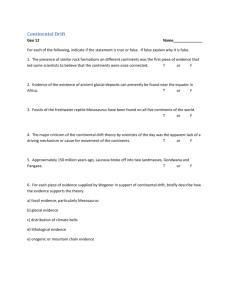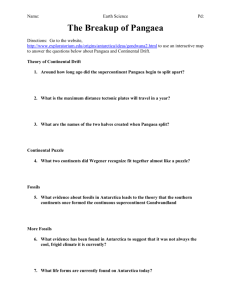
www.amnh.org
A Plate Tectonic Puzzle
Introduction
The Earth’s crust is not a solid shell. It is made up of thick, interconnecting pieces called tectonic plates that fit together
like a puzzle. They move atop the underlying mantle, a really thick layer of hot flowing rock.
By examining evidence such as similar rock layers in various places, fossilized desert belts, the distribution of fossils, and
the physical shapes of continents, scientists have concluded that the Earth’s continents were once all connected to form
a “supercontinent” called Pangaea that was surrounded by an enormous ocean. In this activity, students will use the
different kinds of evidence to reconstruct how the Earth may have looked approximately 220 million years ago.
Objectives
Students will use logic and the evidence to reconstruct the position of large islands and continents as they appeared 220
million years ago. They will understand the theory of continental movement and plate tectonics. The student should be
able to describe how scientists use different kinds of evidence to form theories.
Continental Drift is the movement of the Earth’s continents in relation to one another.
1660: Francis Bacon
Noticed that the coastlines of Africa and South America had similar, matching shapes
1858: Antonio Snider
Published 1st map with Africa & South America joined together – theorized they seperated during Noah’s flood.
1904: Eduard Suess
Found that the rock structures on either side of the Atlantic Ocean were very similar – but this was explained by
the collapse below sea level of a supposed continent in between, called ‘Atlantis’.
1910: F.B. Taylor
He envisaged a ‘mighty creeping movement’ of the Earth’s crust and collisions with other continents to explain
certain mountains across the world. eg: the Himalayas and the Alps.
1912: Alfred Wegener
His theory was called ‘Continental Displacement’ later titled ‘Continental Drift’. His book contained some major
lines of evidence:
the jigsaw fit – the very closest match between the coastlines of South America and Africa
fossil evidence - the same animal & plant fossils are located on separate continents across the ocean
Continental movement – we have current data showing that the plates are moving today
1937: Alexander Du Toit
Compiled significant geological evidence to support the ‘continental drift’ idea (ie: matching rock types on either
side of the Atlantic)
1956: SK Runcorn et al
Evidence showed the magnetic poles (North and South Pole) of the Earth had moved. It was later shown that it
was not the Poles that had moved, but the continents!
1962: Harry Hess
Proposed that new ocean floor was created in the center of oceans, and then moved sideways.
1965: J. Tuzo Wilson
Proposed that the Earth was divided into several large ‘plates’ that fitted together like a puzzle, with the pieces
moving apart as the sea floors spread.
1967: Jason Morgan, Dan McKenzie and Xavier le Pichon
Developed all the earlier ideas in to the current Continental Drift/Plate Tectonic Theory
© 2007 American Museum of Natural History. All Rights Reserved.
1
www.amnh.org
Today scientist have gathered data showing concept that continental movement happens slowly on a daily basis and
plate tectonic action does change the surface of the earth. Looking at a world map, carefully look at the major
continents and their location today. Consider how Europe, Africa, South America, and North America might fit together
as puzzle pieces. As you work through this be prepared to write a statement that might explain this fit. We will be
looking at the Earth as it was millions of years ago when the continents were joined together in one supercontinent
called Pangaea. Using some of the same evidence that scientists use, you will reconstruct this supercontinent.
You will be cutting out the two sets of continents and some of the larger islands of the Earth and assembling one set as
the earth is today and a second set the way scientists think they appeared 220 million years ago. Using two adjecent
pages in your notebook draw a circle on each to represent the globe. Next, cut out the islands and continents.
Using the evidence (symbols) on the continents and islands to reconstruct Pangaea, the supercontinent, you will be able
to see the supporting data for continental drift. Using the physical shape of continents, age of rock layers, fossilized
desert belts, and the distribution of fossils, and the fit of the continents and islands- a more complete data package will
be presented regarding Pangaea. Not all the boundaries may touch perfectly and that there might be areas where water
separated some of the continents. Label your maps Current World and Pangaea.
A Plate Tectonics Puzzle
Solve the puzzle to discover what the Earth looked like 220 million years ago.
What’s the code? Use the legend to identify the symbols on each island or continent.
Puzzle me this. Look at the shapes of continents and islands. What landmasses seem to fit together?
Let’s rock! Examine the evidence and try to match up landmass boundaries that show similar rock strata,
fossilized desert belts, and dinosaur fossils.
Hold that Pose. Look over the arrangement of the continents and islands and decide if the position of any of
them should change. When you are satisfied with your map of Pangaea, tape or glue it down on the world map.
Did You Know?
Tectonic plates are made of both continental and oceanic crust. The land that we see is the continental crust,
about 30 kilometers (19 mi) thick. Under the sea, the heavier oceanic crust is much thinner, about 8 to 10
kilometers (5 to 6 mi) thick.
Plates move about 8 centimeters (3 in) per year. That’s about as fast as a fingernail grows in a year!
The tallest mountains in the world are still growing. About 60 million years ago, the Himalayan Mountains
formed when the Indian Plate crashed into the Eurasian Plate. Today the two plates are still colliding and the
Himalayas continue to rise.
Los Angles sits on the Pacific Plate that is moving northwest and San Franciso sits on the North American Plate
that is moving southeast. Moving towards each other at the rate of 5 centimeters (2 in) a year, someday these
two cities maybe neighbors!
© 2007 American Museum of Natural History. All Rights Reserved.
2
www.amnh.org
© 2007 American Museum of Natural History. All Rights Reserved.
3
www.amnh.org
N
W
E
S
© 2007 American Museum of Natural History. All Rights Reserved.
4
www.amnh.org
A Plate Tectonics Puzzle
LANDMASSES TO CUT OUT
Cut out and place this legend in your notebook:
LEGEND
Europe & Asia
Africa
Australia
South America
India
BELOW sea level
North America
Antarctica
ABOVE
level sea level
© 2007 American Museum of Natural History. All Rights Reserved.
basalt
desert
Plateosaur
us
Phytosaur
amphibian
Rhynchosaur
5










